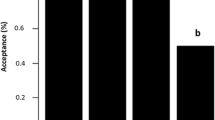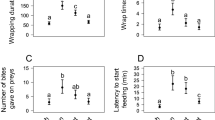Abstract
Versatile predatory tactics might favor success during intra-guild predation. In the case of spiders, the preditory spitting spiders (Scytodidae) invade webs and feed on certain weaver spiders. Based on preliminary observations of Scytodes globula, we tested if this spider species as predator could feed on the sympatric hacklemesh weaver Metaltella simoni (Amphinectidae) as host, or if the host spider could prevent the attack. We exposed adult females of M. simoni on 2-week-old webs to adult female spitting spiders. The spitting spider preyed on the host spider in 28 % of the 72 trials in which the two spider species interacted. Leaving the retreat, approaching the predator, and touching the invader apparently made the host spider vulnerable to predation in 55 % of those interactions; therefore, those were considered risky behaviors. To the contrary, the host spider had a success rate of 67 % of surviving predation by performing defensive behaviors (moving hind legs, performing defensive displays). In four trials, the invader performed a defensive spit to deter the attack of the host spider, which points to the versatility of this trait. We found no effect of body size ratio of the spiders on the outcome of the interactions. The host spider left the retreat after the spitting spider entered its web, suggesting that the spitting spider could be performing aggressive mimicry, but notion is supported by only indirect evidence and needs further exploration. In summary, behavioral interplay mediated the outcome of the interactions between the two coexisting predators assessed in our study.




Similar content being viewed by others
References
Abràmoff MD, Magalhães PJ, Ram SJ (2004) Image processing with ImageJ. Biophot Int 11:36–42
Ades C, Ramires EN (2002) Asymmetry of leg use during prey handling in the spitting spider Scytodes globula (Scytodidae). J Insect Behav 15:563–570
Ades C, Ramires EN, Marcon MR (2010) Asymmetry and experience in the predatory probing behavior of spitting spiders Scytodes globula Nicolet, 1849 (Araneae, Scytodidae). Rev Bras Zoocien 12:91–94
Aisenberg A, Toscano-Gadea CA, Ghione S (2011) Guía de arácnidos del Uruguay. Ediciones de la Fuga, Montevideo
Arim M, Marquet PA (2004) Intraguild predation: a widespread interaction related to species biology. Ecol Lett 7:557–564
Barrantes G, Eberhard WG (2007) The evolution of prey-wrap** behaviour in spiders. J Nat Hist 41:1631–1658
Blamires SJ, Chao YC, Liao CP, Tso IM (2011) Multiple prey cues induce foraging flexibility in a trap-building predator. Anim Behav 81:955–961
Briceño RD, Eberhard WG (2012) Spiders avoid sticking to their webs: clever leg movements, branched drip-tip setae, and anti-adhesive surfaces. Naturwissenschaften 99:337–341
Carvalho LA, Souza ES, Willemart RH (2012) Behavioral analysis of the interaction between the spitting spider Scytodes globula (Araneae: Scytodidae) and the harvestmen Discocyrtus invalidus (Opiliones: Gonyleptidae). J Arachnol 40:332–337
Clements R, Li D (2005) Regulation and non-toxicity of the spit from the pale spitting spider Scytodes pallida (Araneae: Scytodidae). Ethology 111:311–321
Coelho L, Aisenberg A, Costa FG (2010) Testing female receptiveness to novel or previous mating partners in a wolf spider. Behavior 147:383–395
Costa FG, Simó M (2014) Fenología de las arañas epígeas de una zona costera del sur de Uruguay: un estudio bianual con trampas de caída. Bol Soc Zool Uruguay 23(1):1–15
Costa FG, Simó M, Aisenberg A (2006) Composición y ecología de la fauna epígea de Marindia (Canelones, Uruguay) con especial énfasis en las arañas: un estudio de dos años con trampas de intercepción. In: Menafra R, Rodríguez-Gallego L, Scarabino F, Conde D (eds) Bases para la conservación y el manejo de la costa uruguaya. Vida Silvestre Uruguay, Montevideo, pp 427–436
Denno RF, Mitter MS, Langellotto GA, Gratton C, Finke DL (2004) Interactions between a hunting spider and a web-builder: consequences of intraguild predation and cannibalism for prey suppression. Ecol Entomol 29:566–577
Escalante I (2013) Ontogenetic and sexual differences in exploration and web construction in the spider Physocyclus globosus (Araneae: Pholcidae). Arachnology 16:61–68
Gilbert C, Rayor RS (1985) Predatory behavior of spitting spiders (Araneae: Scytodidae) and the evolution of prey wrap**. J Arachnol 13:231–241
Gonzaga MO, Santos AJ, Dutra GF (1998) Web invasion and araneophagy by Peucetia tranquillini Mello-Leitão, 1992 (Araneae, Oxyopidae). J Arachnol 26:249–250
Hammer Ø, Harper DAT, Ryan PD (2001) PAST: Paleontological statistics software package for education and data analysis. Palaeontol Electron 4(1). Available at: http://palaeo-electronica.org/2001_1/past/issue1_01.htm
Henschel JR, Jocqué R (1994) Bauble spiders: a new species of Achaearanea (Araneae: Theridiidae) with ingenious spiral retreats. J Nat Hist 28:1287–1295
Herberstein ME, Wignall A (2011) Deceptive signals in spiders. In: Herberstein ME (ed) Spider behavior flexibility and versatility. Cambridge University Press, Cambridge
Hronsky M (2006) Magnetic resonance study of the spider Nephila edulis and its liquid dragline silk. PhD and Habilitation thesis. Swiss Federal Institute of Technology, Zurich. doi:10.3929/ethz-a-005299740
Ingram T, Svanba R, Kraft NJB, Kratina P, Southcott L, Schluter D (2012) Intraguild predation drives evolutionary niche shift in threespine stickleback. Evolution 66:1819–1832
Jackson RR (1992) Eight-legged tricksters. Spiders that specialize in catching other spiders. Bioscience 42:590–598
Jackson RR, Brassington RJ (1987) The biology of Pholcus phalangioides (Araneae, Pholcidae): predatory versatility, araneophagy and aggressive mimicry. J Zool 211:227–238
Jackson RR, Pollard SD (1996) Predatory behavior of jum** spiders. Annu Rev Entomol 41:287–308
Jackson RR, Whitehouse MEA (1986) The biology of New Zealand and Queensland pirate spiders (Araneae: Mimetidae): aggressive mimicry, araneophagy and prey specialization. J Zool 210:279–303
Jackson RR, Wilcox RS (1990) Aggressive mimicry, prey-specific predatory behaviour and predator recognition in the predator- prey interactions of Portia fimbriata and Euryattus sp., jum** spiders from Queensland. Behav Ecol Sociobiol 26:111–119
Jackson RR, Li D, Fijn N, Barrion AT (1998) Predator-prey interaction between aggressive-mimic jum** spiders (Salticidae) and araneophagic spitting spiders (Scytodidae) from the Philippines. J Insect Behav 11:319–342
Jackson RR, Pollard SD, Li D, Fijn N (2002) Interpopulation variation in the risk related decisions of Portia labiata, an araneophagic jum** spider (Araneae, Salticidae), during predatory sequences with spitting spiders. Anim Cogn 5:215–223
Jarmar EAR, Jackson RR (1986) The biology of Taieria erebus (Araneae, Gnaphosidae), an araneophagic spider from New Zealand: Silk utilisation and predatory versatility. N Z J Zool 13:521–541
Konigswald A, Lubin Y, Ward D (1990) The effectiveness of the nest of a desert widow spider, Latrodectus revivensis, in predatory deterrence. Psyche 97:75–80
Landolfa MA, Barth FG (1996) Vibrations in the orb web of the spider Nephila clavipes: cues for discrimination and orientation. J Comp Physiol A 179:493–508
Li D (1996) Prey preference of specialized jum** spiders (Araneae: Salticidae). PhD thesis. University of Canterbury. Christchurch
Li D, Jackson RR, Barrion AT (1999) Parental and predatory behaviour of Scytodes sp., an araneophagic spitting spider (Araneae: Scytodidae) from the Philippines. J Zool 247:293–310
Masters WM, Markl HS, Moffat AJM (1986) Transmission of vibration in a spider’s web. In: Shear WA (ed) Spiders: webs, behavior and evolution. Stanford University Press, Stanford, pp 49–69
Nelson X, Jackson RR (2011) Flexibility in the foraging strategies of spiders. In: Herberstein ME (ed) Spider behaviour: flexibility and versatility. Cambridge University Press, Cambridge, pp 31–56
Nelson X, Jackson RR (2012) The role of numerical competence in a specialized predatory strategy of an araneophagic spider. Anim Cogn 15:699–710
Nentwig W (1985) Feeding ecology of the tropical spitting spider Scytodes longipes (Araneae, Scytodidae). Oecologia 65:284–288
Opell BD (2013) Cribellar thread. In: Nentwig W (ed) Spider ecophysiology. Springer, Berlin, pp 303–315
Perkins TA, Riechert SE, Jones TC (2007) Interactions between the social spider Anelosimus studiosus (Araneae, Theridiidae) and foreign spiders that frequent its nests. J Arachnol 35:143–152
Polis GA, Myers CA, Holt RD (1989) The ecology and evolution of intraguild predation: potential competitors that eat each other. Annu Rev Ecol Syst 20:297–330
Ramires EN (1999) Uma abordagem comparativa ao comportamento defensivo, agonístico e locomotor de três espécies de aranhas do gênero Loxosceles (Sicariidae). PhD thesis. Instituto de Psicología, Universidad de São Paulo, São Paulo
Riechert SE, Hedrick AV (1990) Levels of predation and genetically based anti-predator behaviour in the spider, Agelenopsis aperta. Anim Behav 40:679–687
Rojas A (2011) Sheet-web construction by Melpomene sp. (Araneae: Agelenidae). J Arachnol 39:189–193
Simó M, Laborda Á, Jorge C, Guerrero JC, Alves Dias M, Castro M (2011) Introduction, distribution and habitats of the invasive spider Badumna longinqua (L. Koch, 1867) (Araneae: Desidae) in Uruguay, with notes on its world dispersion. J Nat Hist 45:1637–1648
Soley F, Taylor PW (2012) Araneophagic assassin bugs choose routes that minimize risk of detection by web–building spider. Anim Behav 84:315–321
Suter RB, Stratton GE (2009) Spitting performance parameters and their biomechanical implications in the spitting spider, Scytodes thoracica. J Insect Sci 9:1–15
Vetter RS (2013) Scavenging behavior in spitting spiders, Scytodes (Araneae: Scytodidae). J Arachnol 41:392–394
Whitehouse MEA (1987) “Spider eat spider”: the predatory behavior of Rhomphaea sp. from New Zealand. J Arachnol 15:355–362
Whitehouse MEA, Agnarsson I, Miyashita T, Smith D, Cangialosi K, Masumoto T, Li D, Henaut Y (2002) Argyrodes: Phylogeny, sociality and interspecific interactions–a report on the Argyrodes symposium, Badplass 2001. J Arachnol 30:238–245
Wise DH (1993) Spiders in ecological webs. Cambridge University Press, Cambridge
Yasuda H, Kikuchi T, Kindlmann P, Sato S (2001) Relationships between attack and escape rates, cannibalism, and intraguild predation in larvae of two predatory ladybirds. J Insect Behav 14:373–384
Acknowledgments
We thank M. Masís for her extensive help in measuring the body size of the spiders. We also thank E. Stanley, L. Montes de Oca, S. Fierro, M. J. Albo, V. Mello, C. Toscano-Gadea, and all of the staff of the Laboratorio de Etología, Ecología y Evolución of the IIBCE for their assistance in the field and in laboratory during this project. D. Li, R. H. Willemart, R. R. Jackson, F. Pérez-Miles, M. Simó, and C. Viera provided important guidance and suggestions, as well as the literature to improve this project. Two anonymous reviewers contributed substantially to the improvement of of this manuscript. Financial support was provided by PEDECIBA (AA), ANII (AA and FGC), and the SEP-UCR (IE).
Author information
Authors and Affiliations
Corresponding author
Electronic supplementary material
Below is the link to the electronic supplementary material.
About this article
Cite this article
Escalante, I., Aisenberg, A. & Costa, F.G. Risky behaviors by the host could favor araneophagy of the spitting spider Scytodes globula on the hacklemesh weaver Metaltella simoni . J Ethol 33, 125–136 (2015). https://doi.org/10.1007/s10164-014-0420-6
Received:
Accepted:
Published:
Issue Date:
DOI: https://doi.org/10.1007/s10164-014-0420-6




